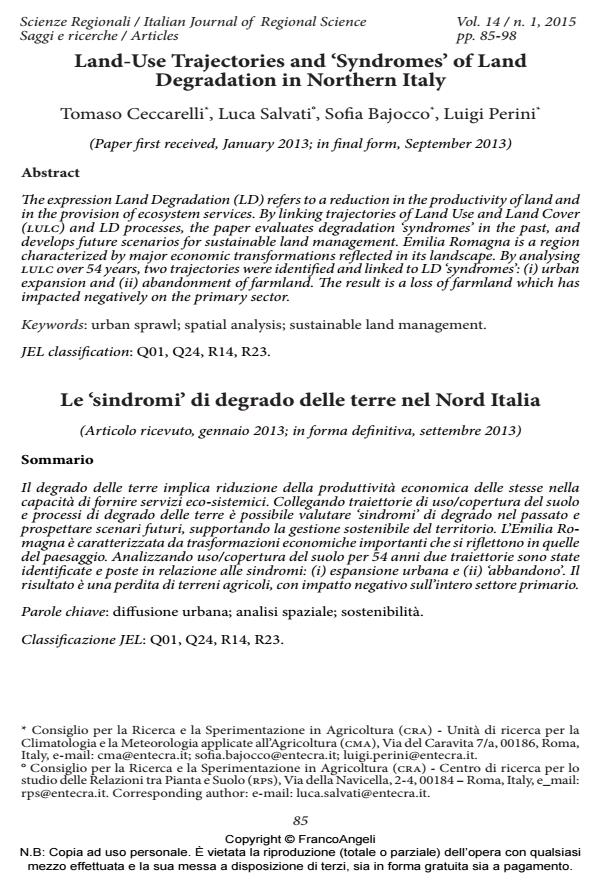Land-Use Trajectories and ‘Syndromes’ of Land Degradation in Northern Italy
Titolo Rivista SCIENZE REGIONALI
Autori/Curatori Tomaso Ceccarelli, Luca Salvati, Sofia Bajocco, Pier Luigi Perini
Anno di pubblicazione 2015 Fascicolo 2015/1
Lingua Inglese Numero pagine 14 P. 85-98 Dimensione file 220 KB
DOI 10.3280/SCRE2015-001005
Il DOI è il codice a barre della proprietà intellettuale: per saperne di più
clicca qui
Qui sotto puoi vedere in anteprima la prima pagina di questo articolo.
Se questo articolo ti interessa, lo puoi acquistare (e scaricare in formato pdf) seguendo le facili indicazioni per acquistare il download credit. Acquista Download Credits per scaricare questo Articolo in formato PDF

FrancoAngeli è membro della Publishers International Linking Association, Inc (PILA)associazione indipendente e non profit per facilitare (attraverso i servizi tecnologici implementati da CrossRef.org) l’accesso degli studiosi ai contenuti digitali nelle pubblicazioni professionali e scientifiche
The expression Land Degradation (LD) refers to a reduction in the productivity of land and in the provision of ecosystem services. By linking trajectories of Land Use and Land Cover (lulc) and LD processes, the paper evaluates degradation ‘syndromes’ in the past, and develops future scenarios for sustainable land management. Emilia Romagna is a region characterized by major economic transformations reflected in its landscape. By analysing lulc over 54 years, two trajectories were identified and linked to LD ‘syndromes’: (i) urban expansion and (ii) abandonment of farmland. The result is a loss of farmland which has impacted negatively on the primary sector.
Il degrado delle terre implica riduzione della produttività economica delle stesse nella capacità di fornire servizi eco-sistemici. Collegando traiettorie di uso/copertura del suolo e processi di degrado delle terre è possibile valutare ‘sindromi’ di degrado nel passato e prospettare scenari futuri, supportando la gestione sostenibile del territorio. L’Emilia Romagna è caratterizzata da trasformazioni economiche importanti che si riflettono in quelle del paesaggio. Analizzando uso/copertura del suolo per 54 anni due traiettorie sono state identificate e poste in relazione alle sindromi: (i) espansione urbana e (ii) ‘abbandono’. Il risultato è una perdita di terreni agricoli, con impatto negativo sull’intero settore primario.
Parole chiave:Diffusione urbana; analisi spaziale; sostenibilità.
Jel codes:Q01, Q24, R14, R23
- Indicators of sustainable forest management to evaluate the socio-economic functions of coppice in Tuscany, Italy F. Riccioli, R. Fratini, E. Marone, C. Fagarazzi, M. Calderisi, G. Brunialti, in Socio-Economic Planning Sciences 100732/2020 pp.100732
DOI: 10.1016/j.seps.2019.100732
Tomaso Ceccarelli, Luca Salvati, Sofia Bajocco, Pier Luigi Perini, Land-Use Trajectories and ‘Syndromes’ of Land Degradation in Northern Italy in "SCIENZE REGIONALI " 1/2015, pp 85-98, DOI: 10.3280/SCRE2015-001005